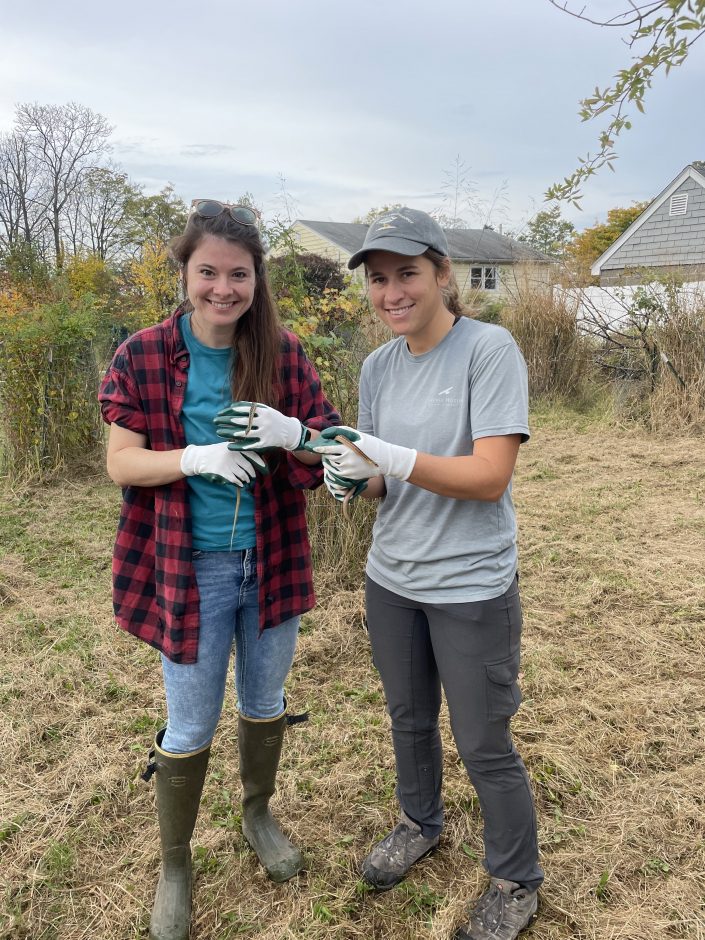CWFNJ Returns to Blue Acres Tremley Point for Fall Planting
by Sherry Tirgrath, Wildlife Biologist
Restoring floodplains and protecting urban communities may not sound like a typical workday for the biologists of Conserve Wildlife Foundation of NJ (CWFNJ). However, multiple staff and board members of CWFNJ were present at the annual Blue Acres Floodplain Restoration Fall Planting and Clean-up Day on October 27th, clearing weeds, trash and planting new trees and shrubs at the Tremley Point restoration site in Linden. Blue Acres, a program created by the New Jersey Department of Environmental Protection, helps residents in low-lying areas that are subject to repeated flooding by buying out their properties and aiding in homeowner relocation. The acquired properties eventually become buffer zones, such as floodplains, that protect surrounding communities from the impact of storms and rising sea levels by acting as natural floodwater storage. The land purchased through the Blue Acres program may also be restored into functional wetlands, habitat for wildlife and open green space for the community to enjoy. Blue Acres not only provides disaster relief for residents whose homes have been destroyed or damaged by flooding and surges caused by large storms, but also contributes to the NJ Climate Change Resilience Strategy by proactively creating wetlands and floodplains to lessen the severity of future flood events.

Located near Marshes Creek, a tributary of the Rahway River, the Blue Acres site in Tremley Point has been undergoing floodplain construction since 2020, while planning and permitting started back in 2014. Funding provided through grants and privately by Phillips 66 Bayway Refinery brought the project into fruition. A team of dedicated volunteers from Phillips 66, Groundwork Elizabeth, the City of Linden Department of Public Works, Infineum, Enviroscapes, CWFNJ and the community meet every year to clean debris and plant native trees and shrubs on the parcels upland from the developing floodplain. These plantings help beautify the area, create green space, and even provide habitat for various wildlife. The native plantings also stabilize land near waterways and reduce the threat of invasive plant species encroaching into the restoration site, which can alter soil chemistry and composition, crowd out important native species and promote erosion in flood-prone areas. Multiple rain gardens, scattered throughout the area, attract pollinators, and help filter polluted run-off from paved surfaces. These rain gardens have also been maintained and cleared of invasive species by the volunteer teams over the years.

CWFNJ has also been heavily involved in the management of phragmites and other invasive vegetation at the Blue Acres site along Marshes Creek for the past four years. Phragmites has become the dominant species along the creek edges and perimeter of the site, drying up the waterway and preventing the transition of the area into a wetland. Each fall, CWFNJ biologists have treated and cut back a significant portion of the phragmites, but it will take many more years of management and cooperation from the surrounding landowners for those efforts to take control over the invasive population.

During the planting event on October 27th, CWFNJ Executive Director, Liz Silvernail, board trustee, Marty McHugh, and staff biologist, Christine Healy, were asked to speak alongside Phillips 66 Public Affairs Manager, Nancy Sadlon, Linden DPW’s Joe Chrobak and Groundwork Elizabeth’s Beren Delgado on the significance of the work being done at Tremley Point. It’s important for the volunteers to understand why the site is so valuable once it’s been restored and how they’re making a huge impact. Piece by piece, the Tremley Point Blue Acres site is becoming a green haven for wildlife and the community to enjoy, while also providing a service in protecting existing structures from flood damage. CWFNJ looks forward to continuing this partnership with Phillips 66 and making their vision a reality.
Discover more from Conserve Wildlife Foundation of NJ
Subscribe to get the latest posts sent to your email.